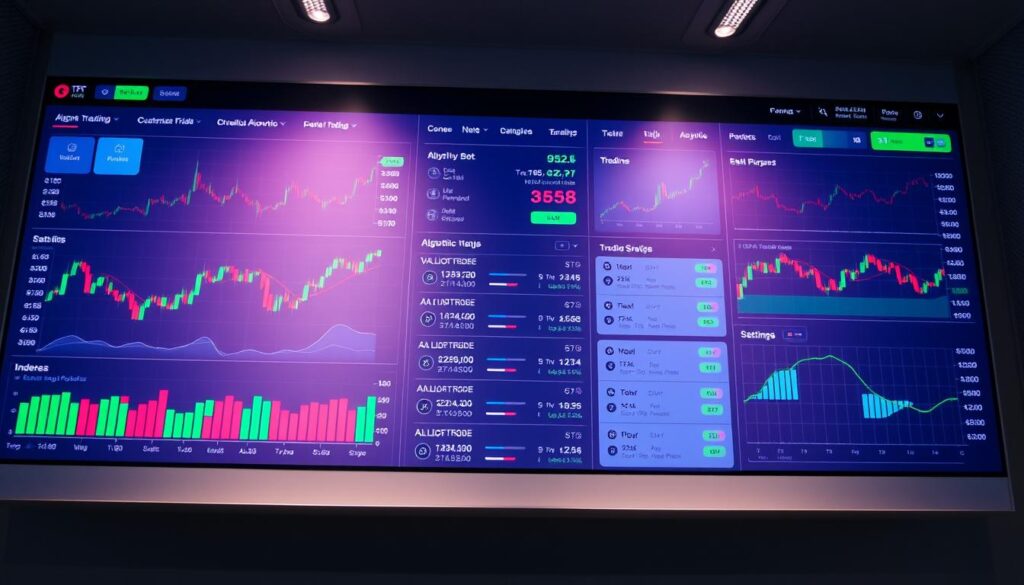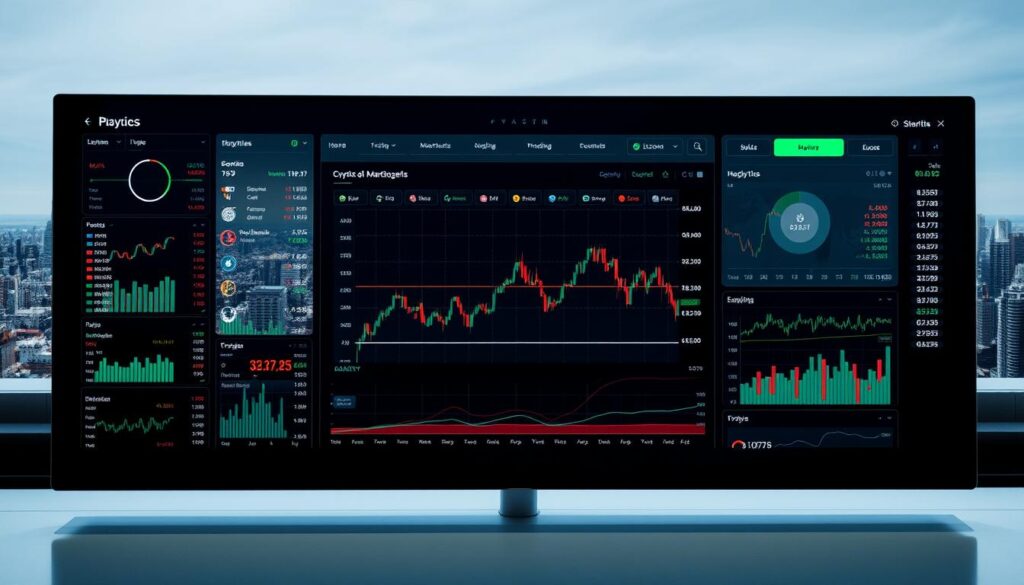Modern technology continues to reshape how investors interact with digital asset markets. Sophisticated software now handles complex tasks that once required hours of manual analysis. These systems use algorithms to scan real-time data, identify patterns, and execute actions faster than any human could.
Round-the-clock operation gives these tools a critical edge in markets that never sleep. Unlike traditional methods, they eliminate emotional decision-making, which often leads to costly mistakes. Backtesting capabilities allow users to refine approaches using historical data before risking actual funds.
Volatile conditions demand quick responses, and that’s where these solutions excel. They adapt to sudden price shifts while maintaining strict adherence to predefined rules. Many platforms now integrate with major exchanges, providing seamless access to global opportunities.
Key Takeaways
- 24/7 market monitoring capabilities outperform manual tracking
- Emotion-free execution reduces impulsive decisions
- Real-time analysis identifies emerging trends instantly
- Customizable rules align with personal risk tolerance
- Continuous adaptation to shifting market dynamics
- Integration with multiple exchanges expands opportunities
Introducing the World of AI Crypto Trading Bots
Digital markets never sleep, but neither do the advanced tools monitoring them. These programs combine pattern recognition with lightning-fast execution, turning complex data streams into actionable insights. Users define parameters once, and the software handles the rest – scanning prices, analyzing trends, and placing orders across global exchanges.
Continuous operation separates these systems from manual approaches. While traditional methods demand constant screen time, these solutions work during market spikes and late-night dips alike. They process thousands of data points per second, identifying opportunities humans might miss.
Three core components power modern platforms:
| Feature | Manual Trading | Bot Trading |
|---|---|---|
| Operation Hours | Limited by human capacity | 24/7 without breaks |
| Decision Speed | Minutes to hours | Milliseconds |
| Emotion Factor | High influence | Zero emotional input |
| Market Adaptation | Slow adjustments | Real-time updates |
| Learning Capacity | Static knowledge | Improves with experience |
Advanced algorithms form the backbone of these systems. They assess risk levels, calculate position sizes, and execute trades when conditions match predefined rules. Historical data analysis helps refine strategies over time, creating self-optimizing workflows.
Security protocols ensure funds remain protected during operations. Most platforms use encrypted APIs to connect with exchanges, keeping assets in user-controlled wallets. This setup minimizes exposure while maintaining full transaction visibility.
Understanding AI Crypto Trading Bots and Their Mechanisms
Today’s trading tools rely on intricate systems that merge real-time information with predictive analytics. These solutions connect directly to digital exchanges through secure APIs, creating a constant flow of market updates. Multi-source data collection forms their foundation—they analyze price charts, social chatter, blockchain activity, and breaking news simultaneously.
- Continuous scanning of global exchanges for price shifts
- Instant processing of historical patterns and live events
- Risk calculations using mathematical probability models
- Automatic order placement through exchange integrations
Machine learning algorithms detect hidden opportunities in chaotic markets. They compare current situations against decades of historical patterns, adjusting strategies as new information emerges. This adaptive approach helps maintain effectiveness during sudden volatility shifts.
Execution speed separates advanced tools from basic software. When conditions match predefined rules, trades happen faster than blinking—typically under 50 milliseconds. Portfolio adjustments occur automatically, balancing asset allocations based on changing market conditions without human intervention.
These systems evolve through reinforcement learning. Each completed trade provides feedback that refines future decisions, creating self-improving strategies. Users maintain control through customizable parameters that align with personal financial goals and risk preferences.
Exploring Key Features of Top Crypto Trading Bots
Leading platforms combine multiple functionalities to create comprehensive market solutions. Their core strength lies in transforming raw data into actionable insights through sophisticated processing methods.

Advanced Data Analysis and 24/7 Operation
These systems analyze terabytes of information daily from price charts, social platforms, and global news. Real-time sentiment tracking spots emerging trends faster than manual monitoring. Continuous operation captures opportunities during off-hours when traditional markets close.
Reinforcement learning helps platforms adapt to new patterns. Historical simulations test strategies against decades of market behavior before live deployment. This combination creates self-improving workflows that evolve with shifting conditions.
Automated Portfolio Management and Social Trading
Smart allocation tools maintain balanced holdings through automatic rebalancing. Users set risk thresholds, and the system adjusts positions during volatility spikes. Dynamic stop-loss mechanisms protect investments while allowing profit potential.
Community-driven features let traders mirror successful strategies from verified experts. This collaborative approach combines automated efficiency with crowd-sourced wisdom. Multi-exchange compatibility ensures access to diverse liquidity pools across global platforms.
Diving into Automated Strategies and Market Performance
Market dynamics demand precision tools that adapt to rapid changes while maintaining strategic discipline. Sophisticated systems employ diverse approaches to navigate shifting conditions, each designed for specific scenarios. Scalping tactics thrive in liquid markets, capturing microscopic price gaps through rapid-fire execution cycles.

Momentum-based methods track emerging patterns across multiple timeframes. These solutions identify breakout signals before major price movements occur, capitalizing on crowd psychology. Statistical models power mean reversion approaches, targeting assets that stray from historical norms.
| Approach | Time Frame | Best For |
|---|---|---|
| High-Frequency | Milliseconds | Liquid pairs |
| Trend Riding | Hours/Days | Volatile markets |
| Arbitrage | Seconds | Multi-exchange gaps |
| Portfolio Balancing | Continuous | Risk management |
Cross-platform arbitrage exploits temporary price mismatches between exchanges. This method requires split-second execution and robust connectivity. Portfolio optimization algorithms work silently in the background, adjusting allocations based on real-time volatility metrics.
Narrative-driven approaches monitor social sentiment and news cycles. These systems position assets early in trending conversations, exiting before hype fades. Each methodology combines mathematical rigor with market intuition, creating adaptable frameworks for various environments.
Product Roundup: Evaluating Leading Trading Platforms
Digital asset markets require specialized tools that match diverse investment styles. Seven platforms stand out for their unique approaches to market navigation. Each offers distinct features catering to different skill levels and objectives.

ArbitrageScanner dominates cross-exchange opportunities, scanning 40+ markets for price gaps. Its wallet analysis tools help users spot emerging trends while securing 15-50% monthly returns through rapid arbitrage execution.
Cloud-based Cryptohopper supports 75 digital assets across major exchanges. The platform combines social features with automated execution, letting users mirror proven strategies from experienced traders. Real-time alerts keep investors informed during volatile periods.
| Platform | Focus | Exchanges | Unique Tools | Best For |
|---|---|---|---|---|
| TradeSanta | Beginner strategies | Binance, OKX | Long/short templates | New users |
| 3Commas | Portfolio management | 16+ platforms | SmartTrade terminals | Advanced traders |
| Photon | Solana ecosystem | Raydium, Orca | Sub-second execution | Speed-focused users |
| Kryll | Strategy building | Multiple DEXs | Visual workflow editor | Custom solutions |
Specialized options like Photon excel in specific ecosystems. Its Solana-focused tools process transactions 5-10 seconds faster than competitors. Telegram-integrated Trojan simplifies DEX operations through chat commands.
TradeSanta’s intuitive dashboard reduces setup time for newcomers. Preconfigured templates help users launch strategies within minutes. 3Commas appeals to professionals with multi-exchange portfolio tracking and advanced order types.
Kryll’s visual editor lets traders build custom workflows without coding. Backtesting features validate strategies against historical data before live deployment. These platforms demonstrate how tailored solutions meet varied market demands.
How AI Bots Analyze Real-Time Market Conditions
Modern analytical engines process information streams at unprecedented speeds. These platforms track price fluctuations, social chatter, and blockchain movements simultaneously. Their ability to cross-reference diverse inputs creates actionable insights from chaotic market noise.

Data Synthesis Engines
Sophisticated processors evaluate multiple variables:
| Data Source | Function | Impact |
|---|---|---|
| Price Trends | Track micro-movements | Identifies entry/exit points |
| Social Sentiment | Measures crowd psychology | Predicts hype cycles |
| On-Chain Analytics | Monitors wallet activity | Spots whale movements |
| Macro Signals | Assesses global events | Anticipates regulatory shifts |
Pattern Recognition Systems
Natural language processors scan news articles and forum discussions. They distinguish between factual reports and speculative content. Contextual analysis helps predict how specific events might influence asset valuations.
Leading platforms like those reviewed in this comprehensive guide combine these techniques. They correlate historical patterns with live developments to forecast price trajectories. Multi-layered verification processes reduce false signals during volatile periods.
Real-time blockchain scanners add another dimension. They detect unusual transaction volumes between major wallets. This often signals impending market movements before public announcements surface.
Customizable Strategies to Match Risk Tolerance and Goals
Tailored approaches dominate modern market navigation. Sophisticated platforms now let users craft workflows that mirror their financial objectives. This personalization bridges the gap between algorithmic precision and individual comfort levels.
Backtesting and Simulation Capabilities
Historical performance analysis forms the bedrock of reliable systems. Platforms simulate strategies against years of market data, revealing potential weaknesses. Users see how their approach would’ve handled Black Swan events or bull markets before risking capital.
| Simulation Feature | Historical Testing | Live Trading |
|---|---|---|
| Data Accuracy | Precise historical records | Real-time variables |
| Risk Exposure | Controlled environment | Actual funds at stake |
| Adjustment Flexibility | Unlimited iterations | Market-time constraints |
| Cost Factors | Simulated fees | Actual transaction costs |
Adjustable Parameters for Personalized Trading
Granular controls put users in the driver’s seat. Position sizes adapt to account balances, while stop-loss triggers respond to volatility thresholds. Entry rules combine technical indicators with fundamental analysis filters.
Leading solutions reviewed in this platform comparison offer dynamic risk ceilings. Exposure limits automatically scale during market turbulence. Profit targets adjust based on evolving asset correlations.
Reinforcement learning optimizes settings over time. The system suggests parameter tweaks after analyzing performance patterns. Users maintain final approval, ensuring alignment with personal comfort zones.
Integration with Major Exchanges and Trading Tools
Seamless connectivity forms the backbone of modern digital asset management. Leading systems link directly to platforms like Binance and Coinbase through encrypted APIs. This creates a secure pipeline for real-time data flow and instant trade execution.
Multi-platform access transforms how users interact with global markets. A single dashboard can monitor price variations across 40+ venues simultaneously. Key advantages include:
- Instant detection of arbitrage opportunities between exchanges
- Consolidated liquidity pools for larger order execution
- Unified tracking of assets spread across different platforms
Security remains paramount in these integrations. Systems use limited-permission API keys that only allow trade execution and data access. Funds stay in user-controlled wallets, eliminating third-party custody risks.
Advanced functionality extends beyond basic buying and selling. Margin positions and futures contracts become manageable through integrated interfaces. This flexibility lets sophisticated strategies thrive while maintaining strict risk parameters.
Leveraging Machine Learning for Smarter Trade Execution
Market analysis has entered a new era of precision through self-teaching systems. These platforms evolve using neural networks that digest historical patterns and live data streams simultaneously. Unlike static tools, they refine decision-making processes with each interaction, uncovering hidden correlations across diverse market signals.
Reinforcement learning drives continuous improvement, letting systems adjust tactics based on real-world outcomes. For instance, platforms like Binance Sensei optimize asset picks by analyzing thousands of variables, while tools such as CryptoHopper rebalance portfolios during volatility spikes. This adaptability often leads to 20-40% efficiency gains in dynamic environments.
Sophisticated models process terabytes of information in milliseconds, predicting price movements before traditional indicators react. Hedge fund-grade algorithms now power some platforms, enabling retail users to access institutional-level strategies. These systems excel at identifying micro-trends in chaotic markets, executing actions faster than manual methods permit.
For those exploring adaptive systems, modern solutions offer unprecedented customization. Users set risk parameters once, and the technology handles complex calculations behind the scenes. Real-time adjustments ensure strategies remain aligned with shifting conditions without constant oversight.
The future lies in self-improving algorithms that learn from both successes and setbacks. As markets grow more complex, these intelligent tools provide a critical edge through relentless optimization and pattern discovery.


No comments yet